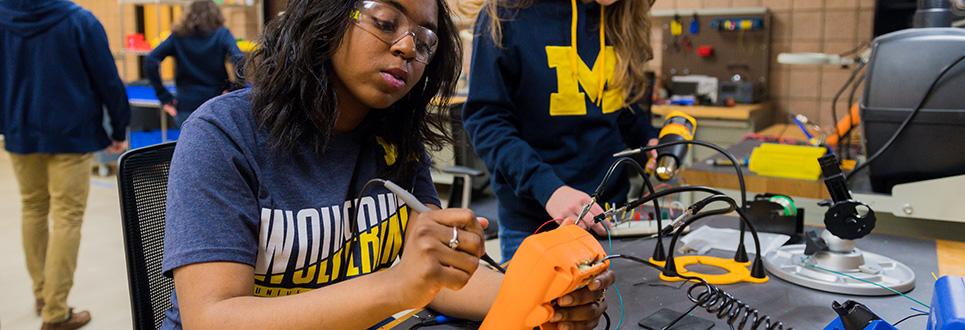FAQs


Does the U-M Child Care Subsidy Program require that I use a child care provider licensed by the State of Michigan?
Yes. The provider must be licensed by the State of Michigan. If you use an unlicensed provider or a provider licensed in a different state, contact the Office of Financial Aid to discuss your options. Sometimes these costs can be included as an educational expense so that you can pursue other types of scholarship/grant funding through your department or additional borrowing.
How is financial need determined for the Child Care Subsidy?
The child care subsidy is need-based funding. Eligibility is based on a formula including a student’s Cost of Attendance less contributions from income and assets and other sources of financial aid. All income and assets are documented on the Free Application for Federal Student Aid, or FAFSA, which is used to calculate financial aid.
Why are Graduate Student Instructor (GSI) appointments and fellowship funding treated differently when determining financial need?
The GSI stipend is considered regular income, whereas a fellowship stipend is considered financial aid, so the two are treated differently in the formula. Earnings are reported on the FAFSA and used to calculate eligibility, allowing certain offsets for living expenses based on federally established standards. Financial aid, such as GSI tuition waivers and fellowships, reduce financial need on a dollar-for-dollar basis.
What is the impact if I receive additional assistance after the child care subsidy is awarded?
This might include graduate students receiving grants for travel and dissertations or undergraduates receiving a scholarship. These resources could affect eligibility and should always be reported to the Office of Financial Aid. However, many graduate students may have additional, related costs that can lessen or eliminate this impact. Document these costs and submit them to our office for review. Be proactive by reporting any grant to our office and carefully document expenses relating to it.
Why does the university require partners/spouses to be enrolled in a college degree program or be employed in order to qualify for a child care subsidy?
If a partner/spouse is not working or enrolled in school, it is the expectation that this person would be available to care for a child or children. The funds for this program are limited, so they are always awarded as a matter of policy to families with both parents enrolled in school, or those that have one parent in school and one working (or a combination of being employed and in school). Financial aid staff verifies the partner/spouse's employment and/or enrollment as part of this program. The U-M Community has resources available to assist with child care and other family issues. These include the U-M Work-Life Resource Center’s website.
What does it mean to have a partner/spouse that is gainfully employed?
This can include full- or part-time employment in a traditional vein, including both working at an employer's site or telecommuting in a flexible work situation. It can also include self-employment that brings in a living wage for the family. Our office may require substantiation from an employer as to an employee's unique work situation or copies of tax returns to verify self-employment income. The final determination of an employment situation will be made by the Office of Financial Aid during application review.
I won’t be enrolled in credit hours, but I will be working on research or my dissertation for the term I would like to apply for — can I still qualify for the Child Care Subsidy program?
Students who are officially placed on a Detached Study or Non-Enrolled Degree Required (NEDR) status by their program will meet the enrollment requirements for the Child Care Subsidy. These are special enrollment statuses for students whose academic pursuits equate to half-time enrollment, but are not enrolled in courses or being charged tuition or a candidacy fee. To determine if (or when) you might be designated with one of these statuses, please refer to your program advisor or the Office of Academic Records and Dissertations. Note: This process has replaced the PhD Non-Enrollment form which is no longer necessary.
What about summer camps? How are they handled?
The purpose of the subsidy is to assist with licensed child care costs; it is not intended to pay for participation in education or enrichment programs. Summer camps licensed or administered by a licensed day care facility or provider meet the requirements; the subsidy does not cover children's participation in competitive sport programs such as soccer or baseball teams.
Additional research funding reduced my Child Care Subsidy. Can I get it back?
The Child Care Subsidy, along with many other forms of financial aid authorized through the Office of Financial Aid, are based upon both the Cost of Attendance (COA) and the demonstrated need of the student. To determine need, the university uses a “standard” Cost of Attendance (sometimes referred to as your budget) that is the same for all students in your particular program. We subtract your Student Aid Index (the number that is given to you when you complete a FAFSA) from the Cost of Attendance and the resulting amount is your demonstrated need.
For example: if your COA is $48,000 and your Student Aid Index is $5,000, your demonstrated need would be $43,000. If your financial aid, including the Child Care Subsidy, was reduced after receiving other assistance, your total aid exceeded your demonstrated need.
It may be possible to restore some, or all, of the reduced aid through a Cost of Attendance re-evaluation. There are two processes you can use:
This same process can be used to determine if the Office of Financial Aid can restore other forms of assistance such as a Federal Direct Unsubsidized Loan and/or a Federal Direct Graduate PLUS Loan.